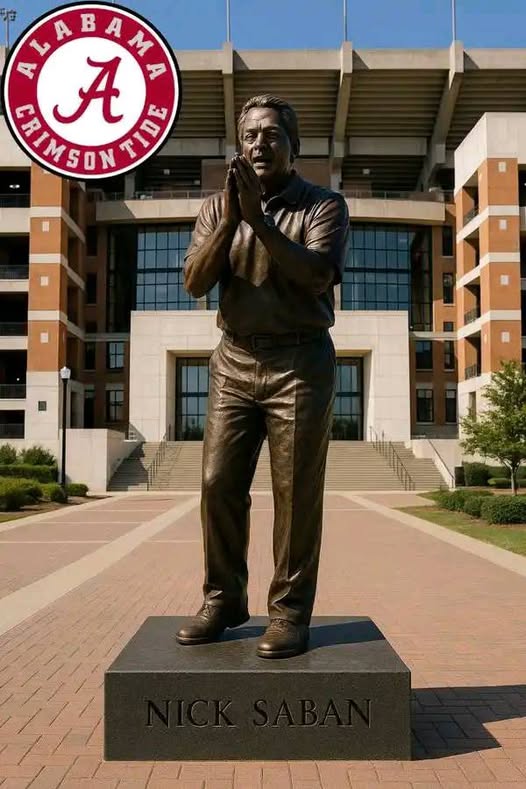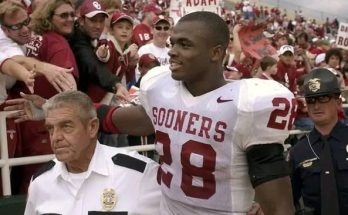The University of Alabama is once again honoring one of college football’s greatest icons. In a move that cements the legacy of a coach who transformed an entire program and left an indelible mark on the sport, the Crimson Tide is set to unveil a second statue of Nick Saban—this time in a prominent new position on the famed “Walk of Champions” outside Bryant-Denny Stadium.
The announcement came on the heels of the annual A-Day spring game, sparking a wave of enthusiasm across Tuscaloosa and throughout the Crimson Tide faithful nationwide. The new statue, set for unveiling during the 2025 season, aims to recognize not just Saban’s unmatched accomplishments on the field, but also his contributions to the University of Alabama and college football as a whole.
A Legacy Too Big for One Statue
The existing Nick Saban statue, placed alongside those of Alabama’s other national championship coaches, was erected in 2011 after Saban delivered the university its 13th claimed national title in 2009. That statue, modest and classical in design, celebrated a monumental milestone—but as the years passed and Saban’s reign continued, it became clear his impact transcended even those early expectations.
Now, with seven national championships (six at Alabama), multiple SEC titles, and a transformative cultural imprint, the University decided it was time to create a second monument—one befitting the full arc of his 17-season run as head coach of the Crimson Tide.
“Coach Saban didn’t just win football games,” Alabama athletic director Greg Byrne said during the unveiling press conference. “He redefined what it meant to be elite in college football. He built a dynasty, mentored generations of young men, and elevated this university in every measurable way. A second statue is not about redundancy—it’s about reverence.”
A New Symbol in the Heart of Tuscaloosa
The new statue will be more dynamic than the original, capturing Saban in a more iconic stance: standing with one arm extended mid-coaching instruction, headset in place, a determined look frozen in bronze. The design, approved by both the university and the Saban family, is meant to embody the tireless energy, focus, and intensity that became synonymous with the Alabama football program from 2007 to 2023.
Standing over 12 feet tall, the new statue will be placed near the entrance to the “Walk of Champions,” a high-traffic path for fans and players on game day. This new placement not only allows for higher visibility but also aligns symbolically with the theme of leadership, as Saban’s likeness will be placed at the literal gateway to Alabama’s football cathedral.
The sculpture is being created by nationally acclaimed artist Blair Buswell, who also designed busts for the Pro Football Hall of Fame. Buswell described the commission as “an incredible honor” and stated his goal is to capture “the relentless excellence and discipline Coach Saban demanded—not just from his players, but from himself.”
Reflections from the Saban Family
The Saban family released a statement expressing gratitude for the honor and their continued connection to the university and its fanbase.
“We are deeply moved by this tribute,” the statement read. “Our time in Tuscaloosa has meant the world to us. This statue is not just about football victories—it is about relationships, commitment, and the spirit of excellence that defines Alabama.”
Nick Saban himself, always humble in the face of personal accolades, downplayed the need for a second statue but acknowledged the importance of legacy.
“This program isn’t about one person,” Saban said during the ceremony. “It’s about the players, the coaches, the staff, the fans, and the university community. I’m honored, but I hope this statue reminds people of what’s possible when you stay focused on the process and put the team first.”
The Saban Effect: More Than Wins
To truly understand why a second statue is being built, one has to look at the broader “Saban Effect.”
When Nick Saban arrived in 2007, Alabama was mired in mediocrity, desperate for a return to its storied past. In just his second season, Saban led the Crimson Tide to a 12-0 regular season. The following year, in 2009, Alabama went undefeated and won its first national championship since 1992.
From there, the dynasty took off.
Under Saban’s leadership, Alabama won national titles in 2009, 2011, 2012, 2015, 2017, and 2020. He also coached two Heisman Trophy winners (Mark Ingram and DeVonta Smith), produced dozens of first-round NFL Draft picks, and turned Tuscaloosa into the center of the college football universe.
Enrollment at the University of Alabama surged. Donations and endowments increased. Facilities were upgraded. The “Process”—Saban’s famous philosophy of disciplined execution—became a blueprint for success across multiple sports and beyond the athletic department.
“Coach Saban changed the standard,” said former Alabama quarterback and current ESPN analyst Greg McElroy. “He didn’t just restore Alabama football—he elevated it to a level no one thought possible in the modern era. This new statue is about honoring the architect of the greatest dynasty college football has ever seen.”
Impact on Future Generations
The timing of the statue unveiling also coincides with a new era in Alabama football under head coach Kalen DeBoer, who took over after Saban’s retirement in early 2024. DeBoer, a rising star in the coaching world, has spoken often about his deep respect for Saban and the legacy he inherits.
“I tell the players all the time: we stand on the shoulders of giants,” DeBoer said. “Coach Saban’s shadow looms large—not as a burden, but as a beacon. His example motivates us to uphold the Alabama standard every day.”
DeBoer and his staff are already leveraging the Saban legacy in recruiting, development, and program culture. The second statue, set to be unveiled prior to a marquee home game this fall, will serve as a tangible reminder of what’s possible within the Crimson Tide tradition.
Incoming freshman quarterback Jamal Woods, one of the nation’s top recruits, summed up the sentiment of many current players: “When you come to Bama, you know whose footsteps you’re following in. Seeing that statue every day will remind us what it means to wear that jersey.”
Fan Reaction: A Celebration of Greatness
News of the second statue was met with overwhelming support from Alabama fans, many of whom took to social media to share stories and photos of their favorite Saban moments—whether it was the thrilling comeback against Georgia in the 2018 national championship or his trademark sideline scowls that signaled his high expectations.
Fan club president and Tuscaloosa native Linda Crawford called the announcement “the right thing at the right time.”
“We always knew the first statue was just the beginning,” Crawford said. “Coach Saban gave us years of pride, joy, and unity. This new statue gives us another way to say thank you.”
Preserving History, Inspiring the Future
The unveiling of the second Nick Saban statue is more than a ceremony—it’s a declaration. A declaration that greatness matters. That leadership is worth honoring. That the traditions of Alabama football are rooted in the pursuit of excellence.
As the university prepares to unveil the sculpture later this year, the air around Tuscaloosa is thick with anticipation. It’s not just a tribute to a coach—it’s a monument to a golden age.
Nick Saban didn’t just win championships—he changed what was possible.
Now, as Alabama looks toward the future under new leadership, the towering bronze figure of Saban will stand as a guardian of the past and an inspiration for what lies ahead.
Sidebar: Fast Facts About Nick Saban’s Alabama Career
- Tenure: 2007–2023
- National Championships: 6 (2009, 2011, 2012, 2015, 2017, 2020)
- SEC Championships: 8
- Overall Record at Alabama: 201–29
- NFL Draft Picks: 44 First-round selections under Saban
- Heisman Winners: 2 (Mark Ingram, DeVonta Smith)
- Graduation Success Rate (GSR): Over 90% for much of Saban’s tenure
- “The Process”: A widely admired philosophy centered on discipline, consistency, and focus on execution rather than outcomes
Final Word
The second Nick Saban statue doesn’t replace the first. It expands the narrative. From the moment he stepped foot in Tuscaloosa, Saban brought vision, drive, and belief to a program yearning for revival. What followed was a legacy that may never be matched.
And now, forever forged in bronze, that legacy will continue to walk with Alabama—through the tunnel, onto the field, and into history.



